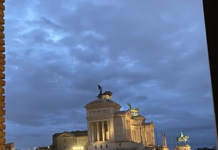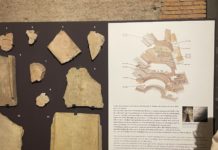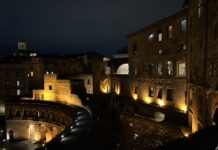What we know today as “trade” or the exchange of goods and services, is incredibly complex. But when compared to the Mercati di Traiano Museo dei Fori Imperiali, one is forced to examine our own complexity, and wonder if this complexity is even a relevant factor of comparison. Ancient Romans might have used a different currency, spoken a different language, and known more about hardship, but the fundamental elements of humanity always shine through. On our visit to Museo dei Fori Imperiali we let elements of space, beauty, and human ingenuity guide us through millennia of extremely well preserved sculpture and structure, ending an incredible terrace finale.
In the eternal city of Rome, everything is ancient. Terracotta cracks along the walls of apartment buildings, weeds and ivy creep around every corner, ornately framed windows are commonplace… The essence of Rome is entropy and stone. When walking through the city center, buildings take on a more smooth, industrial look which creates a feeling of scale and textured repetition. I introduce Rome in this way to illustrate a point that when I saw the entrance to the Museo dei Fori Imperiali, I was in awe of its antiquity.
Trajan’s great halls stand proudly over the buildings around it. Others are industrial and matted with dirt, but itself, handmade and preserved. The smaller, more perforated brink indicates a different time period. One of war and craftsmanship. The intentional use of space to guide the viewer however, only continues on the inside. There are many floors to Trajan’s great halls, and we likely got to see most of them, although our tour was short and we had to make up for some lost time, I got the feeling that there was much more to experience.
The entrance is a quite open space with a ceiling so high that you can view the second floor, and in the center is the iconic, “Reconstruction of the order on the façade of the porticoes in the Forum of Augustus.” The name is mouthful but the beauty is unmatched. Each member of our tour helped themselves to a photo of it. The sides of this central hall have connected rooms which invite the viewer in. And within these rooms are preserved pieces of ancient history. A popular one was the “Sculpted head reworked to portray Constantine.”
As our guide informed us about the rooms and their content, I kept getting distracted by the visual playground around me. We continued to the end of the central hall after a while, and followed a more constricted path, through a collection of marble sculptures. We went up a set of stairs visible from the first floor of the central room. It all came together after that.
After some more walking and some more talking, we exited the building through the terrace. The peak of the visit for me. As the roman forum is in a centralized area of rome with lots of antiquity, rarely do you get an elevated view. And as I could see all of these iconic structures my heart was content with my decision of coming to this country.
The terrace overlooked Trajan’s market. The weathered brick I mentioned earlier was everywhere. Not only is the brick an indicator of time, but also place. There are a few structures this ancient and most of them are located in central Rome. Each of them has this texture. The Trajan forum is where horticulture items, spices, oil, and wine were exchanged. A system of trade so ancient and barebones we assume the act was simple. Looking at the rubble of this once great place reminds me that time takes all. Unforgiving yet necessary.
We reentered through the way we came after a class photo. On our way down to the ground floor however, we went deeper into the structure. Our final stop was a part of a recent exhibition of an ancient elephant.
“the fourth section displays the remains of the skull and left defence (tusk) of the ancient elephant Elephas (Palaeoloxodon) antiquus, found in the geological stratum about 11 metres from the top of the hill. Three watercolours by Barosso and an oil painting by Ferretti take the spectator through the opening phases of the Velia cut, with the first appearance of the Colosseo, the bringing to light of the remains of the elephant’s skull and defence lying in the path of the Via dell’Impero and, finally, the majestic geological stratification brought to light by the advancing work.” – Mercati di Traiano Museo dei Fori Imperiali
The skull was in pieces and took on a damaged appearance. The Ivory tusk once likely a pale yellow or white, was now gray and earth brown. The skull had degraded so much over the years, its layers looked geological. Parts of the skull evoked an image of bark, or wood chips. With the combination of the tusk and the head, the scale of this object was fascinatingly large.
We arrived with the expectation of seeing “more ancient rome.” But we left with a feeling of gratitude. The world known under Trajan’s empire, millenia ago had expectations for the future. They had certain truths and untruths. And today walking through these spaces, those truths are splayed in a fashion meant to intrigue and inform.
I loved the museum, and I hope to continue to learn about this ancient world.
Elijah Lucio








